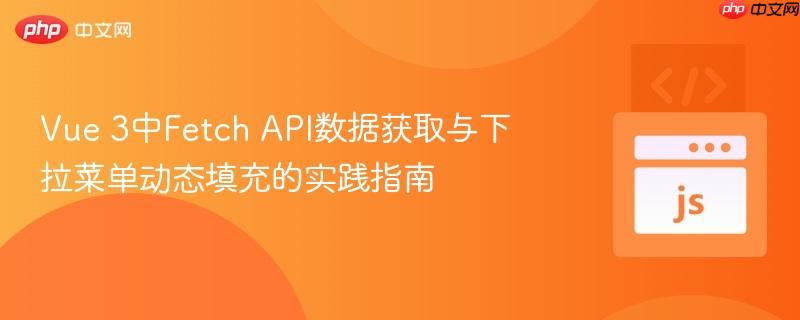
本文深入探讨了vue 3应用中通过fetch api获取数据并动态填充下拉菜单时遇到的常见问题及解决方案。重点讲解了如何正确处理api返回的数组结构数据,通过数据转换(如使用`map`和`set`)提取并去重所需字段,以适配组件的渲染需求,确保下拉菜单能够正确显示数据。
在Vue 3开发中,从后端API获取数据并将其渲染到前端UI组件(如下拉菜单)是常见的需求。然而,API返回的数据结构往往不直接与前端组件的期望格式匹配,这就需要进行适当的数据转换。本文将以一个具体的案例为例,详细阐述如何解决Fetch API获取数据后,下拉菜单未能正确填充的问题。
假设我们有一个Vue 3组件,旨在从一个交通事件API获取数据,并根据事件的“原因”、“条件”和“事件类型”来填充三个独立的下拉菜单。API接口(例如:https://eapps.ncdot.gov/services/traffic-prod/v1/incidents?verbose=true)返回的是一个事件记录的数组,每条记录都包含reason、condition和incidentType等字段。
初始的Vue组件代码可能如下所示:
<template>
<div>
<div>to wit: {{ dropdownData }}</div>
<select v-model="reason">
<option v-for="r in dropdownData.reasons" :value="r">{{ r }}</option>
</select>
<select v-model="condition">
<option v-for="c in dropdownData.conditions" :value="c">{{ c }}</option>
</select>
<select v-model="incidentType">
<option v-for="type in dropdownData.incidentTypes" :value="type">{{ type }}</option>
</select>
<button @click="getData">Get Data</button>
</div>
</template>
<script>
export default {
data() {
return {
reason: null,
condition: null,
incidentType: null,
dropdownData: {
reasons: [],
conditions: [],
incidentTypes: []
}
}
},
mounted() {
this.fetchDropdownData()
},
methods: {
fetchDropdownData() {
fetch(`${import.meta.env.VITE_API_VERBOSE}`)
.then((response) => {
if (!response.ok) {
throw new Error('Network response was not ok')
}
return response.json()
})
.then((data) => {
// 初始尝试:直接赋值
this.dropdownData = {
reasons: [...data.reasons], // 假设data中直接有reasons数组
conditions: [...data.conditions],
incidentTypes: [...data.incidentTypes]
}
})
.catch((error) => {
console.error('Error:', error)
})
},
getData() {
// 使用选中的值进行后续操作
}
}
}
</script>尽管Fetch API调用成功并返回了数据(例如418条记录),但下拉菜单却未能填充。dropdownData对象在模板中显示为空数组。
立即学习“前端免费学习笔记(深入)”;
问题的核心在于API返回的数据结构与组件中dropdownData的期望结构不匹配。API返回的data是一个数组,例如:
[
{ "id": 1, "reason": "Accident", "condition": "Wet", "incidentType": "Collision" },
{ "id": 2, "reason": "Construction", "condition": "Dry", "incidentType": "Roadwork" },
{ "id": 3, "reason": "Accident", "condition": "Icy", "incidentType": "Collision" }
// ... 更多事件对象
]而我们的dropdownData期望的是一个包含reasons、conditions、incidentTypes等属性的对象,每个属性的值都是一个包含所有唯一选项的数组,例如:
{
"reasons": ["Accident", "Construction"],
"conditions": ["Wet", "Dry", "Icy"],
"incidentTypes": ["Collision", "Roadwork"]
}因此,this.dropdownData = { reasons: [...data.reasons], ... } 这样的代码会失败,因为data本身是一个数组,而不是一个直接包含reasons、conditions等属性的对象。我们需要从data数组中的每个事件对象里提取相应的字段,并进行去重处理。
为了解决这个问题,我们需要在fetchDropdownData方法中对API返回的data进行转换。具体步骤如下:
修改后的fetchDropdownData方法如下:
// ... (之前的代码)
fetchDropdownData() {
fetch(`${import.meta.env.VITE_API_VERBOSE}`)
.then((response) => {
if (!response.ok) {
throw new Error('Network response was not ok')
}
return response.json()
})
.then((data) => {
// 确保data是数组,并进行数据转换
if (Array.isArray(data)) {
const reasons = [...new Set(data.map(item => item.reason))];
const conditions = [...new Set(data.map(item => item.condition))];
const incidentTypes = [...new Set(data.map(item => item.incidentType))];
this.dropdownData = {
reasons: reasons.filter(Boolean), // 过滤掉可能的undefined或null值
conditions: conditions.filter(Boolean),
incidentTypes: incidentTypes.filter(Boolean)
};
} else {
console.warn('API returned data is not an array:', data);
// 可以根据实际情况处理非数组数据,例如清空下拉菜单数据
this.dropdownData = { reasons: [], conditions: [], incidentTypes: [] };
}
})
.catch((error) => {
console.error('Error fetching dropdown data:', error);
// 在错误发生时,清空下拉菜单数据或显示错误信息
this.dropdownData = { reasons: [], conditions: [], incidentTypes: [] };
})
},
// ... (后续代码)结合上述修正,完整的Vue 3组件代码如下:
<template>
<div>
<h2>交通事件数据筛选</h2>
<p>当前下拉菜单数据预览: {{ dropdownData }}</p>
<div class="filter-controls">
<label for="reason-select">选择原因:</label>
<select id="reason-select" v-model="reason">
<option :value="null">-- 请选择 --</option>
<option v-for="r in dropdownData.reasons" :key="r" :value="r">{{ r }}</option>
</select>
</div>
<div class="filter-controls">
<label for="condition-select">选择条件:</label>
<select id="condition-select" v-model="condition">
<option :value="null">-- 请选择 --</option>
<option v-for="c in dropdownData.conditions" :key="c" :value="c">{{ c }}</option>
</select>
</div>
<div class="filter-controls">
<label for="incident-type-select">选择事件类型:</label>
<select id="incident-type-select" v-model="incidentType">
<option :value="null">-- 请选择 --</option>
<option v-for="type in dropdownData.incidentTypes" :key="type" :value="type">{{ type }}</option>
</select>
</div>
<button @click="getData">根据选择获取数据</button>
</div>
</template>
<script>
export default {
data() {
return {
reason: null,
condition: null,
incidentType: null,
dropdownData: {
reasons: [],
conditions: [],
incidentTypes: []
}
}
},
mounted() {
// 组件挂载时立即获取数据填充下拉菜单
this.fetchDropdownData()
},
methods: {
async fetchDropdownData() {
try {
// 使用环境变量获取API URL,增强可配置性
const response = await fetch(`${import.meta.env.VITE_API_VERBOSE}`);
if (!response.ok) {
throw new Error(`Network response was not ok: ${response.statusText}`);
}
const data = await response.json();
if (Array.isArray(data)) {
// 提取并去重各个字段的值
const reasons = [...new Set(data.map(item => item.reason))];
const conditions = [...new Set(data.map(item => item.condition))];
const incidentTypes = [...new Set(data.map(item => item.incidentType))];
// 更新响应式数据
this.dropdownData = {
reasons: reasons.filter(Boolean), // 过滤掉可能的undefined/null值
conditions: conditions.filter(Boolean),
incidentTypes: incidentTypes.filter(Boolean)
};
} else {
console.warn('API returned data is not an array. Expected an array of incidents.');
this.dropdownData = { reasons: [], conditions: [], incidentTypes: [] };
}
} catch (error) {
console.error('Error fetching dropdown data:', error);
// 在错误发生时,清空下拉菜单数据或显示错误信息
this.dropdownData = { reasons: [], conditions: [], incidentTypes: [] };
}
},
getData() {
// 此方法用于根据当前选中的下拉菜单值进行进一步操作
console.log('Selected Reason:', this.reason);
console.log('Selected Condition:', this.condition);
console.log('Selected Incident Type:', this.incidentType);
// 例如:根据这些值再次调用API过滤数据,或更新地图显示
alert(`已选择:原因 - ${this.reason}, 条件 - ${this.condition}, 类型 - ${this.incidentType}`);
}
}
}
</script>
<style scoped>
.filter-controls {
margin-bottom: 15px;
}
label {
margin-right: 10px;
font-weight: bold;
}
select {
padding: 8px 12px;
border: 1px solid #ccc;
border-radius: 4px;
background-color: white;
min-width: 150px;
}
button {
padding: 10px 20px;
background-color: #007bff;
color: white;
border: none;
border-radius: 4px;
cursor: pointer;
margin-top: 10px;
}
button:hover {
background-color: #0056b3;
}
</style>注意事项:
在Vue 3应用中,通过Fetch API获取数据并填充下拉菜单是一个常见任务。关键在于理解API返回的数据结构,并根据前端组件的渲染需求进行适当的数据转换。利用Array.prototype.map()进行字段提取和Set进行去重,是处理此类问题的有效方法。同时,良好的错误处理、数据验证和用户体验考量(如默认选项和加载状态)也是构建健壮应用不可或缺的部分。通过本文的实践指南,开发者可以更自信地处理类似的数据绑定场景。
以上就是Vue 3中Fetch API数据获取与下拉菜单动态填充的实践指南的详细内容,更多请关注php中文网其它相关文章!

每个人都需要一台速度更快、更稳定的 PC。随着时间的推移,垃圾文件、旧注册表数据和不必要的后台进程会占用资源并降低性能。幸运的是,许多工具可以让 Windows 保持平稳运行。

Copyright 2014-2025 https://www.php.cn/ All Rights Reserved | php.cn | 湘ICP备2023035733号